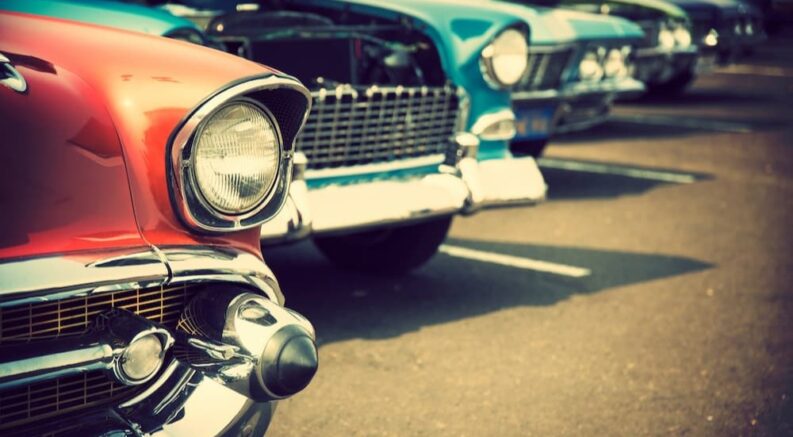For a country of just 10.5 million, Sweden has an outsized presence in the international auto market. This country’s vehicular offerings tend to concentrate on either performance or practicality, ranging from the safety-minded Volvo and its Polestar EV offshoot to the supercar specialists at Koenigsegg and defunct brands like the turbocharger-obsessed Saab.
These brands have made Sweden one of Europe’s major automotive hubs, and motor vehicles are the country’s largest export, with an average annual value of around $20 billion. So, with such an impressive list of homegrown brands to choose from, it might be a little surprising to learn that the country’s dominant automotive subculture revolves around a decidedly impractical class of vehicles that are 5,000 miles and fifty-plus years removed from the Scandinavian Peninsula.
Sweden’s Raggare subculture is basically a Nordic version of the Greaser scene that dominated American high schools, pool halls, and drive-ins throughout the 1950s and ‘60s. Famously immortalized in the Broadway musical “Grease,” its Hollywood adaptation, and other popular culture touchstones like “The Wild One,” “The Outsiders,” and “American Graffiti,” Greasers were known for their leather garb, pomade-laden hair, and, of course, their V8-powered muscle cars. The Pontiac Bonneville serves as a prime example of a Raggare favorite, but any car that features the requisite power, chrome, and gaudy tailfins is usually enough to gain entry into this Swedish subculture.
So how did these fair-haired Scandinavians come to embrace American muscle, and how has Raggare culture managed to stand the test of time? Throw on your leather jacket and slick back your hair as we head up to Sverige for some answers…
Swede Lightnin’
The emergence of Raggare is inexorably tied to Sweden’s decision to stay neutral during World War II. While much of the rest of Europe was a war-torn mess, Sweden’s infrastructure had escaped largely unscathed, and, as a result, the country was able to maintain a lucrative export economy. This was good news for the Swedish economy in general, as there were a lot more jobs (and money) to go around; the youth then took advantage of these rosy economic conditions to buy imported cars, resulting in a large number of American-made models (“Yankees” in Raggare slang) making their way into the Nordic nation.
But it wasn’t just cars that the kids were importing, as adherents tended to embrace all the post-war American trends. From the Rockabilly music and iconic greased-up hair to blue jeans, leather or denim jackets, and the tight white t-shirt (with or without a pack of cigarettes rolled into the sleeve), Raggare almost served as a sort of American cosplay. The Raggare culture soon swept across Scandinavia, finding a foothold in Norway and Finland and eventually expanding to parts of Germany, Denmark, and Austria.
The freewheeling attitude was a big part of the Raggare appeal. It was this American permissiveness that was the real backbone of early Raggare culture. In fact, the term Raggare comes from the Swedish “ragga” which means to flirt or pick up girls. In a relatively conservative society, Raggare allowed the youth to express themselves in a new way that, unsurprisingly, led to a lot of controversy.
Raggare weren’t hardened criminals but rather just bored youth using American culture as a form of self-expression. Violations were pretty tame and typically limited to the odd fight or petty infraction—such as driving without a license or siphoning gas—but even the scuffles were pretty tame by American standards.
“We used to meet up on Sundays to have fights. We were honest fighters. No weapons, no martial arts, no kicking—and if you fell on the ground, it was all over, and you’d buy the guy a drink,” said Georg, a Raggare veteran who was interviewed for a 2009 article from The Guardian.
The real outrage was usually centered around sexuality. The American muscle cars certainly worked a treat when it came to picking up girls, leading to a number of unplanned pregnancies in an era before the birth control pill. The large backseat of the 1950s American muscle car made this sort of hanky-panky all too easy, resulting in a moral panic that even spawned its own “Reefer Madness”-type cautionary film in 1959’s “Raggare!”
Things have certainly changed over the decades. Sweden has largely embraced the unique subculture and even given the Raggare scene the ultimate governmental stamp of approval in the form of its own postal stamp.
Detroit Meets Stockholm
While Raggare might be a wider cultural movement, there’s no underestimating the importance of the cars themselves. The pure size of the preferred American muscle cars informed many aspects of the subculture; the generous dimensions meant that plenty of friends could come along for the ride, while the loud, thirsty V8 engines served as an act of rebellion against the typically reserved Swedish culture and its small, polite cars. While the 1950s American muscle car scene was all about hot rod modifications that could increase power, the sheer size and V8 of the average muscle car was a statement on its own.
Hulking V8s like the Pontiac Bonneville, Dodge Phoenix, and Buick Roadmaster quickly became the go-to ride for the Raggare, but they certainly weren’t alone; American cars of all shapes and sizes could be found at popular Raggare hangouts. These cars were often imported on the cheap and, more often than not, arrived in pretty rough shape; they were typically rehabbed over the course of Sweden’s long winter and finished in time for the summer cruising season.
It’s estimated that Swedes imported as many as 4,000 to 5,000 American-made muscle cars into the country each year, and there’s plenty of anecdotal evidence to back up that claim. One Swedish car restorer estimates that there might be more ‘50s-era classic American cars in the Scandinavian country than in the US itself!
While the 1950s and ‘60s might have represented the true heyday of Raggare culture, the scene is still alive and well. This stands in stark contrast to America’s own Greaser subculture, which, while a dominant cultural force throughout the 1950s and early ‘60s, was soon replaced by the hippies, punks, and other youth styles as the decades rolled on. Raggare, on the other hand, has outlasted the post-war period to become an inexorable part of Swedish culture.
The closest American equivalent would probably be the modern-day Rockabilly subculture, though those pompadour-wearing, polka dot-clad devotees have nothing on the Raggare in terms of sheer numbers. Some estimates put Raggare’s numbers as high as 500,000, which, considering Sweden’s size, amounts to around 5% of the population.
Raggare to Riches
The decline of the big American car on the domestic market has played a significant part in Raggare’s longevity. Poor exchange rates and multiple oil crises through the late ’60s and 1970s saw US drivers give up on their gas-guzzling muscle cars, which then made their way to countries like Sweden. This trend has seen the original generation of Raggares to be supplanted by a new breed of younger disciples who tend to be a little more lax when it comes to vehicular standards.
Typically rural and born of a lower socioeconomic class, modern-day Raggares largely use the subculture as an excuse to cruise around with their friends, draw some stares, and throw back a few drinks. While older Raggares might be dismissive of the ramshackle models piloted by the modern generation, it certainly sounds like they’re upholding some of the tenets.
America’s own classic car culture tends to value immaculately preserved vehicles complete with plenty of polished chrome, original components, and color schemes. The same isn’t necessarily true in today’s Raggare culture, where almost any sufficiently aged, Detroit-born vehicle can gain you entry, regardless of what sort of condition it might be in.
From patchy paint jobs and dented bodies to decals, rust, and decorated interiors, the average Raggare more closely resembles Ricky’s rolling junkheap (a 1975 Chrysler New Yorker) from the popular Canadian sitcom “Trailer Park Boys” rather than the museum-quality rides found at the typical American classic car meet. That’s not to say there aren’t some real beauties to be seen rolling through the streets of Stockholm, but Raggare is as much about the 1950s Greaser culture as it is about the cars themselves.
These days, going Raggare isn’t always easy; importing classic American cars doesn’t come cheap, and neither does gas. At an average of $5.80 a gallon, filling up the tank of a 1959 Pontiac Bonneville will set a driver back a little more than $100. Add in the fact that the ‘59 Bonneville got around 11 MPG, and it’s easy to see why the Raggare is such an investment. These economic realities have led some Raggare fans to ditch true V8 muscle for any American vehicle that fits the bill or, if that’s too pricey, go as far as painting a ubiquitous Volvo black and calling it a day—but such rigs might not pass muster with Raggare diehards, who often refer to such wannabees as “blöjraggare” or “diaper raggare.”
However, the older Raggares haven’t entirely given up on the hobby. Georg, the man mentioned in the 2009 Guardian article, was still hosting Raggare meet-ups at his Arboga garage well into his seventies. Participants spend their time comparing rides, listening to classic American rock n’ roll, and chatting about the good old days.
This same sort of nostalgia is also a mainstay of the Big Power Meet, a classic car show hosted each summer in Lidköping, which features a specific focus on American models from the ‘50s and ‘60s. Said to be one of Europe’s largest classic car shows, the event regularly draws as many as 20,000 cars and 200,000 attendees; it’s full of iconic American muscle cars, Raggare fashion, and, of course, more than a few frosty beers.
The Swedish Greaser Aesthetic
While some automotive subcultures tend to focus solely on the vehicles themselves, Raggare is something of an exception. A JDM fan, low-rider enthusiast, or hot rodder would never dare to show up to a local meet in the sort of disheveled stock models that populate the Raggare scene, but Raggare’s accessibility is a big part of the appeal. While the American-made muscle cars are certainly central to the scene, they’re really just another part of the costume, along with the denim, the pomade, and the white t-shirts.
In reality, Raggare is more about an attitude than any specific accessory, with the Greaser culture and attitudes of 1950s America serving as a sort of excuse for a little self-expression among the country’s disaffected youth. There are still plenty of pristine examples of American automotive excellence to be found at events like the Power Big Meet, but Raggare was always about more than just the cars.




